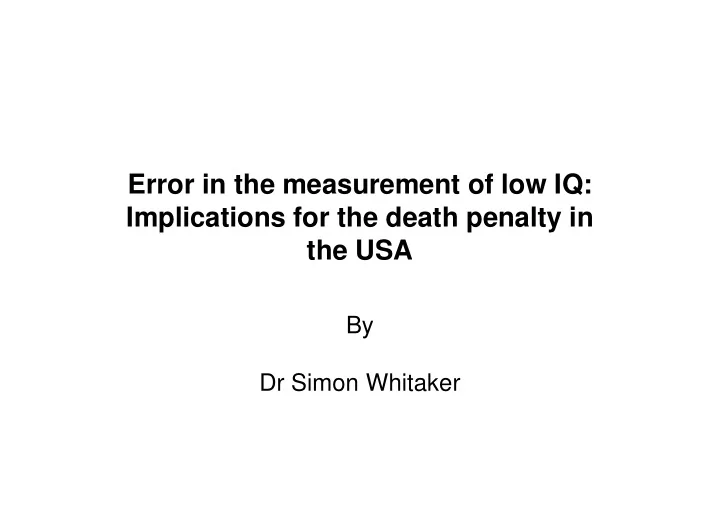

Error in the measurement of low IQ: Implications for the death penalty in the USA the USA By Dr Simon Whitaker
Between 1977 and 2006 thirty three states in the USA executed 1003 people, of whom an estimated 44 had mental retardation (Patton and Keyes 2006). retardation (Patton and Keyes 2006).
In June 2002, the Supreme Court of the United States, in the case of Atkins v. Virginia, made the decision to ban the execution of people with mental execution of people with mental retardation.
The court, however, did not give guidance as to a clear definition of mental retardation and left it up to individual states to produce their own. This has states to produce their own. This has resulted in a range of different definitions of mental retardation (Duvall and Morris 2006; DeMatteo et al 2007).
All the 38 states that allow capital punishment require a sub-average level of intellectual functioning as part of their definition of mental retardation. Twenty of definition of mental retardation. Twenty of these states specify an IQ figure above which a convicted individual would not be considered to have mental retardation and so could not be reprieved from execution on the grounds of mental retardation.
Definition of Learning Disability • An IQ less than 70. • A deficit in adaptive skills. • All occurring before the age of 18 years.
A key question How accurately can we measure IQ in the low range? low range?
IQ Assessments Focus on the commonly used IQ tests: the WISC-III/IV and the WAIS-III These are probably the most well These are probably the most well standardised and researched psychological tests ever produced.
It is claimed that the obtained IQ will be within 5 points of the true IQ on 95% of within 5 points of the true IQ on 95% of assessments.
Sources of error in the measurement of IQ Chance errors: • Lack of internal consistency. • Temporal error. • Scorer error. • Scorer error. Systematic error: • Flynn effect. • Floor effect (low range only). • Lack of consistency between tests .
Chance Error
95% confidence interval If the degree of chance error is known then a 95% confidence interval (95% CI) can be calculated by: 95% CI = 1.96 � SD � � (1-r) 95% CI = 1.96 � SD � � (1-r) SD is the standard deviation of the test and r is the reliability coefficient. It is usually reported to be about 5 points
Temporal Error An estimate of this is given by the test re- test reliability check. The test re-test reliability is the correlation The test re-test reliability is the correlation between the IQ scores obtained by a group of people being given the same test on two occasions.
A meta-analysis A meta-analysis of the literature on the stability of intelligence tests when applied to people with low intellectual ability (IQ<80) was done (Whitaker 2008). The (IQ<80) was done (Whitaker 2008). The mean correlation between first and second test was 0.82. This corresponds to a 95% confidence interval of 12.47 points.
It was also found that 14% of IQs change by 10 points or more between the two assessments. Which is close to what a 95% confidence interval of 12.5 would 95% confidence interval of 12.5 would predict.
Total chance error Temporal error does not include the error due to lack of internal consistency. An estimate of this in the low range is provided by Davis (1966) who in the low range is provided by Davis (1966) who found split-half reliabilities of .90 for children with moderate ID (mean IQ 48) and .97 for those with borderline mental ID (mean IQ 76), the weighted mean reliability being .92.
When this is combined with the temporal error it gives 95% confidence interval of 30 points or 15 points either side of the obtained IQ. obtained IQ. This contrasts with the 5 points cited in the test manuals.
Systematic error
Lack of agreement between tests There is evidence that earlier versions of the WISC and the WAIS did not agree at the low IQ level. We (Gordon, Duff, Davison and Whitaker We (Gordon, Duff, Davison and Whitaker in press) therefore compared the WISC-IV and the WAIS-III in an empirical study on seventeen 16-year-olds in special education.
Results WISC-IV WAIS-III dif r FS IQ 53.00 64.82 11.82 .93
Implications • There is a lot of scope for error in assessment of mental retardation/ intellectual disabilities. • It is posible that people with true IQs less • It is posible that people with true IQs less than 70 are still being executed.
Recommend
More recommend